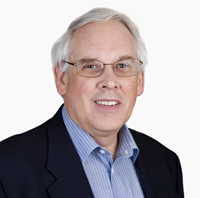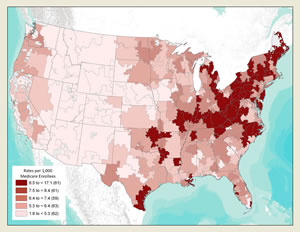Connect Medical and Geographic Histories to Improve Health
By Susan Harp, Esri Writer
"Where do health care and medicine collide with brilliant minds and uninhibited imagination?" That was the slogan of TEDMED 2009, the Technology, Entertainment, and Design in Medicine conference. The answer, according to the organizers of this gathering of forward thinkers in health care and medicine, was supposed to be, "At TEDMED."
 Bill Davenhall, global marketing manager for health and human services, told the TEDMED audience that geography matters in health care. |
But one of the presenters also wanted health care and medicine to collide—with geography and the environment. Bill Davenhall, Esri's global marketing manager for health and human services, used the metaphor of a train wreck to describe to a rapt TEDMED audience in San Diego, California, how each of these elements slammed together during his personal health care journey. His train wreck? A heart attack.
During his presentation Can Geographic Information Keep You Healthy?, Davenhall suggested that a patient's geographic (or place) history is as relevant to personal health as genetics and lifestyle. One reason for including geography is that where you live can expose you to environmental toxins. "I've lived in some of the most polluted areas in the nation," Davenhall said. Listen to Davenhall's TedMed talk.
For the first 19 years of his life, Davenhall was exposed to sulphur dioxide fumes from burning coal waste in Scranton, Pennsylvania. Then he moved to Louisville, Kentucky, where various industries spewed out multiple contaminants. In the 1990s, he relocated to California and breathed smog toxins produced in and around Los Angeles.
Did these exposures contribute to his heart attack? Maybe not, but he made the point that a lifetime of environmental exposures should be considered when deciphering a patient's health problems. Noting that the average physician office visit takes about eight minutes, Davenhall drove home the message that it's too short a time for a physician to make a connection between where a patient has lived and a history of environmental exposures. The physician needs to consider many things, including a patient's place history and its intrinsic context. Those contribute to a more complete picture of the person's health.
"All the rich data collected by such organizations as the National Library of Medicine and the Environmental Protection Agency simply have not entered the picture when it comes to our face-to-face encounters with our physicians. I think this needs to change," said Davenhall. According to Davenhall, the first step to connecting a patient's medical and geographic histories could be achieved using an electronic health record (EHR). The advantage of an EHR is that an accurate, full place history can be filled out just once (maybe even using an iPhone app) and made available to physicians as needed. EHRs might actually lighten the burden of massive record-keeping requirements on the modern physician's office.
 Heart Attack Risks for U.S. Medicare Enrollees, Mapped by County (Data source: Dartmouth Atlas of Health Care) |
However, the second step—the interpretation of geography and environmental exposures—depends on a physician's understanding of the concepts of geo-medicine (the application of spatial analysis methods to medicine). To increase this understanding, Davenhall wants the education of health professionals to include training in geomedicine. The place history of a patient could become a clinical marker and eventually unlock everything known about a patient's health risks related to toxic air, water, ground, and food exposures as well as culture and demographics.
"Ultimately," Davenhall said, "the goal is to help people stay healthy."
Obviously, Davenhall recovered from his heart attack. But his point about geography was made well enough that everyone in the audience craned their necks to see his display of a map showing heart attack rates across the United States. The question in everyone's mind was, "What's the risk where I live?" For Davenhall, risks were high in all three of his hometowns.
After Davenhall's presentation, Alexandra Carmichael, cofounder of CureTogether.com, listed Davenhall's geographic approach as one of her Top 10 Innovations at TEDMED. Scientific American wrote: "Bill Davenhall. . . made a compelling plea to add a history of places to medical information that doctors review."
About TEDMED
The original TED conference, held in 1984, initiated conversations on technology, entertainment, and design. TEDMED 2009, held October 28-30, in San Diego, was the fifth in a series that focused on health. TEDMED was created by Marc Hodosh, consultant and entrepreneur, and Richard Saul Wurman, author of more than 80 books including Information Anxiety; organizer of the original TED conference; and creator of the phrase "information architect." Wurman's newest project, 19.20.21, seeks to identify successful urban design models that can be used to improve the lives of citizens living in megacities.